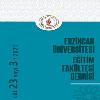ÖĞRENME YETERSİZLİĞİ İLE DİKKAT EKSİKLİĞİ-AŞIRI HAREKETLİLİĞİN KARŞILAŞTIRILMASI
Eğitim sürecinde belirli bir zihinsel, fiziksel veya psikolojik bir nedeni olmadığı halde, başarılı olamayan bir çok çocuk vardır. Bu çocukların büyük bir bölümünün başarısızlığına; dikkat problemi-aşarı hareketlilik veya bazı alanlardaki öğrenme problemleri neden olabilmektedir. Bu problemler, son derece karmaşık ve benzer sonuçlara yol açabildiğinden, bir gruba ait ortak özellikler olarak düşünülmüştür. Bu çalışmada, bir arada görülebilen fakat bir birinden son derece farklı olan bu iki durumun karşılaştırılması yapılmıştır.
Anahtar Kelimeler:
Öğrenme yetersizliği, dikkat eksikliği, aşırı hareketlilik
COMPARISON OF LEARNING DISABILITIES WITH ATTENTION DEFICIT AND HYPERACTIVITY
In education process, without psychological, physical and mental reasons, there are lots of unsuccessful students. Attention problems, hyperactivity and some learning problems may cause for failure in most of students. Since these problems are extremely complex, and bring about similar results, it has been thought common features belong to a group. In this study, two situations that seen together but extremely different each other have been compared.
Keywords:
Learning disabilities, attention deficit disorder, hyperactivity,
___
- American Psyhiatric Associaton (1994). Diagnostic and Statistical Manuel of Mental Disorders (DSM IV). Washington, DC; American Psyhiatric Associaton.
- Doris, J.L (1993). Defeining Learning Disabilities: A History of The Search For Consensus.
- Lyon, GR., Gray, D. B., Kavanagh, J. F., Krasnegor, N.A. (Eds), Better Understanding Learning Disabilities: New Views From Research And Implications for Education and Public Policies (S, 97-116). Baltimore: Paulh Brokes Pub. Comp.
- Dykman, R.A., Ackerman, P.T. (1991). Attention Deficit Disorder and Specific Reading
- Disability: Separate But Often Overlapping Disorders. Journal of Learning Disabilities, 24 (2), 96-103.
- Fowler, M. (1991) Attention Deficit Disorder. Washington, DC: Briefing Paper: Natinoal
- İnformation Center for Children and Youth With Disabilities.
- Goodman, G., Poillion, M.J. (1992). ADD: Acronym for any Dysfunction or Difficulty. The Journal of Special Education, 26 (1), 37-56.
- Heward, w., Orlansky, m.d. (1984). Exceptional children (2’nd ed).Ohio; Charles E: Merill Publishing Company.
- Lerner, J., W. (1993). Leraning Disabilities: Theories, Diagnosis and Teaching Strategies
- (6 Th Ed.). Boston: Houghton, Mifflin Company.
- Margalit, M.Almougy, K (1991.). Clasassroom Behavior and Family Climate in Students with Learning Disabilities and Hiperactive Behevior. Journal of Learning Disabilities, 24 (7), 406-412.
- Murphy, V., Stewart, H.K.(1991). Learning Disabilities And Anttention Deficit-Hiperactivity
- Disorder: And Interactional Perpective. Journal of Learning Disabilities, 24 (7) 386-388.
- Senemoğlu, N., (1997) Gelişim Öğrenme ve Öğretim, Spot Matbaacılık, Ankara, s. 292 Silver, L,B,(1992). The Misunderstood Child (2nd Ed.), Bredenton: Human Service
- Institute, Tabbooks.
- Wong, B.Y.L (1991). Learning About Learnening Disabilities, San Diego, California: Academic Press, Inc.
- Yayın Aralığı: Yılda 4 Sayı
- Başlangıç: 1999
- Yayıncı: Erzincan Binali Yıldırım Üniversitesi
Sayıdaki Diğer Makaleler
İSTANBUL BASININA GÖRE SON OSMANLI MECLİS-İ MEBUSANINDAN BEKLENTİLER
İLKÖĞRETİM İKİNCİ KADEME ÖĞRENCİLERİNİN YAZIM VE NOKTALAMA KURALLARINI UYGULAMA BECERİ DÜZEYLERİ
Ercan KAYA, Durmuş Ali BAL, Fatih SEZEK
BİR VERİ TABANI UYGULAMASI OLARAK ELEKTRONİK PORTFOLYO
V. Aytekin SANALAN, Arif ALTUN
Atatürk’ün Eğitimci Kişiliği Ve Eğitim-Öğretim Boyutlu Düşünceleri
Şule BARAN, Salih DOĞAN, Mehmet YALÇIN
0-6 YAŞ GRUBU ÇOCUKLARDA DİL GELİŞİMİ
ÖĞRENME YETERSİZLİĞİ İLE DİKKAT EKSİKLİĞİ-AŞIRI HAREKETLİLİĞİN KARŞILAŞTIRILMASI
